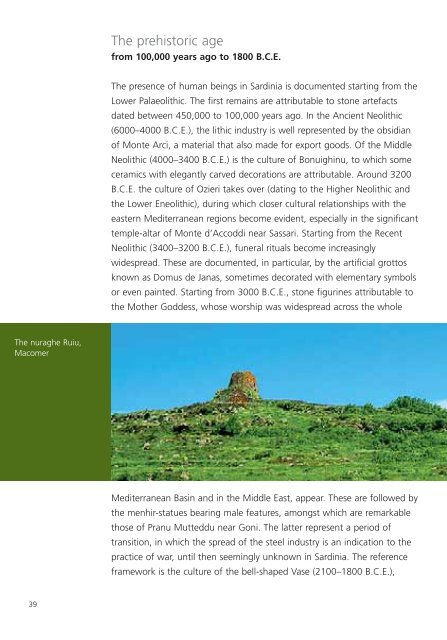You also want an ePaper? Increase the reach of your titles
YUMPU automatically turns print PDFs into web optimized ePapers that Google loves.
The prehistoric age<br />
from 100,000 years ago to 1800 B.C.E.<br />
The presence of human beings in Sardinia is documented starting from the<br />
Lower Palaeolithic. The first remains are attributable to stone artefacts<br />
dated between 450,000 to 100,000 years ago. In the Ancient Neolithic<br />
(6000–4000 B.C.E.), the lithic industry is well represented by the obsidian<br />
of Monte Arci, a material that also made for export goods. Of the Middle<br />
Neolithic (4000–3400 B.C.E.) is the culture of Bonuighinu, to which some<br />
ceramics with elegantly carved decorations are attributable. Around 3200<br />
B.C.E. the culture of Ozieri takes over (dating to the Higher Neolithic and<br />
the Lower Eneolithic), during which closer cultural relationships with the<br />
eastern Mediterranean regions become evident, especially in the significant<br />
temple-altar of Monte d’Accoddi near Sassari. Starting from the Recent<br />
Neolithic (3400–3200 B.C.E.), funeral rituals become increasingly<br />
widespread. These are documented, in particular, by the artificial grottos<br />
known as Domus de Janas, sometimes decorated with elementary symbols<br />
or even painted. Starting from 3000 B.C.E., stone figurines attributable to<br />
the Mother Goddess, whose worship was widespread across the whole<br />
The nuraghe Ruiu,<br />
Macomer<br />
Mediterranean Basin and in the Middle East, appear. These are followed by<br />
the menhir-statues bearing male features, amongst which are remarkable<br />
those of Pranu Mutteddu near Goni. The latter represent a period of<br />
transition, in which the spread of the steel industry is an indication to the<br />
practice of war, until then seemingly unknown in Sardinia. The reference<br />
framework is the culture of the bell-shaped Vase (2100–1800 B.C.E.),<br />
39
















